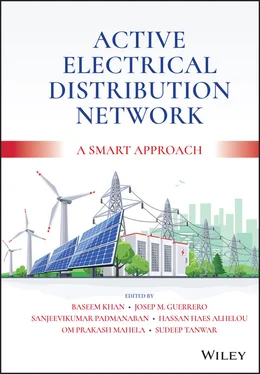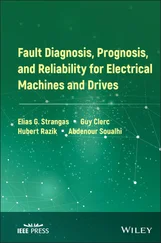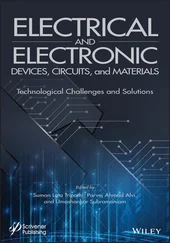Active Electrical Distribution Network
Здесь есть возможность читать онлайн «Active Electrical Distribution Network» — ознакомительный отрывок электронной книги совершенно бесплатно, а после прочтения отрывка купить полную версию. В некоторых случаях можно слушать аудио, скачать через торрент в формате fb2 и присутствует краткое содержание. Жанр: unrecognised, на английском языке. Описание произведения, (предисловие) а так же отзывы посетителей доступны на портале библиотеки ЛибКат.
- Название:Active Electrical Distribution Network
- Автор:
- Жанр:
- Год:неизвестен
- ISBN:нет данных
- Рейтинг книги:5 / 5. Голосов: 1
-
Избранное:Добавить в избранное
- Отзывы:
-
Ваша оценка:
- 100
- 1
- 2
- 3
- 4
- 5
Active Electrical Distribution Network: краткое содержание, описание и аннотация
Предлагаем к чтению аннотацию, описание, краткое содержание или предисловие (зависит от того, что написал сам автор книги «Active Electrical Distribution Network»). Если вы не нашли необходимую информацию о книге — напишите в комментариях, мы постараемся отыскать её.
Discover the major issues, solutions, techniques, and applications of active electrical distribution networks with this edited resource Active Electrical Distribution Network: A Smart Approach
Active Electrical Distribution Network: A Smart Approach
Active Electrical Distribution Network — читать онлайн ознакомительный отрывок
Ниже представлен текст книги, разбитый по страницам. Система сохранения места последней прочитанной страницы, позволяет с удобством читать онлайн бесплатно книгу «Active Electrical Distribution Network», без необходимости каждый раз заново искать на чём Вы остановились. Поставьте закладку, и сможете в любой момент перейти на страницу, на которой закончили чтение.
Интервал:
Закладка:
Various forms of business models adopted to carry out the task of power distribution across various parts of the globe have been summarized along with their merits and demerits. Considering the various functions and the various issues or challenges present in the power distribution sector under a smart grid environment, a new business model described by Jamasb, Thakur, and Bag [6] that has not been adopted by any utility is also discussed in this chapter. This new business model is expected to overcome all the challenges present while fulfilling all future desires of the power distribution sector.
1.2 Importance of the Business Model in the Smart Grid
The smart grid is more technology oriented as compared to the traditional grid. Value from new technology can be captured by a firm in two basic ways: through incorporating the technology in their current businesses or through launching new ventures that exploit the technology in new business arenas. Unlike other tangible products sold in the market that can be stored and sold at a later date, electricity cannot be stored and should be consumed as soon as it is generated. Hence, for other tangible products that are able to capture the value from new technology through storage, electrical businesses must use another way to capture value from new technologies that is more suitable for an electrical business. However, power distribution utilities function under the traditional grid operation mode and are following the trend of technology adoption through storage and hence are failing to capture the values from the newly developed technologies during their transition toward the smart grid. Thus, an alternative way is an essential need under the smart grid operation mode. Various technologies have been developed that could be useful for pursuing different tasks in the distribution business will have to be taken to the market through a venture shaped by a specific business model.
Unless and until it is commercialized, the inherent value of a technology remains latent. A correct business model helps in the commercialization of a new technology and may become the architecture of new revenue. If a firm fails to select a correct business model, technology will yield less value to the firm than might otherwise have been the case. If the firm fails consistently in selecting an appropriate business model, it fails its various commitments. Because of the non-availability of an appropriate business model for the power distribution sector, ideal technologies developed especially for the sector are not being utilized properly toward developing the sector. Various Information Communication Technology (ICT)-based technologies that have been developed especially for the sector are not being properly utilized because of the unavailability of an appropriate business model. Time of day (ToD) or time of usage (ToU) pricing, average billing rate (ABR) fixing, theft control, etc., are being designed through technology implementation, but because of the absence of a right business model, these technologies are inactive in fulfilling their objectives of demand side management.
Similarly, adequate technological developments have already been done for reactive power management and voltage stability control, but they are still failing to meet their objectives because of the absence of a correct business model. Again, the commercial losses (excluding theft) taking place in the sector are very high and cannot be addressed through technology development, although they can be addressed through implementation of a correct business model.
1.3 Electricity Distribution Structures and Business Models
In most countries, transmission systems have been expanded in a planned way based on detailed technical studies, but there is an unplanned and haphazard expansion in the distribution sector with the objective of meeting the growing urgent consumer demand. Due to this reason, the distribution system has become inefficient, leading to the following technical and governance challenges:
Technical challenges: huge aggregate technical and commercial (AT&C) losses, poor power quality, low reliability, etc.
Governance challenges: problems with things related to operation and maintenance, adequate metering, dealing with cross subsidy, energy billing, activity outsourcing, improving financial status of distribution utilities, mechanisms for attracting private investors, etc.
Hence, many distribution utilities across different countries are characterized as inefficient with a low productive system. To overcome technical- as well as governance-related difficulties, basic and radical restructuring of the power sector has become imperative [7]. Unbundling, corporatization, privatization, and outsourcing were the major initiatives under restructuring. As a result, four different models to carry out the function of power distribution have evolved across the globe, viz. government-owned Distribution Company, privately owned Distribution Company, Public–Private–Partnership Model, and Distribution Franchisee, as shown in Figure 1.1.
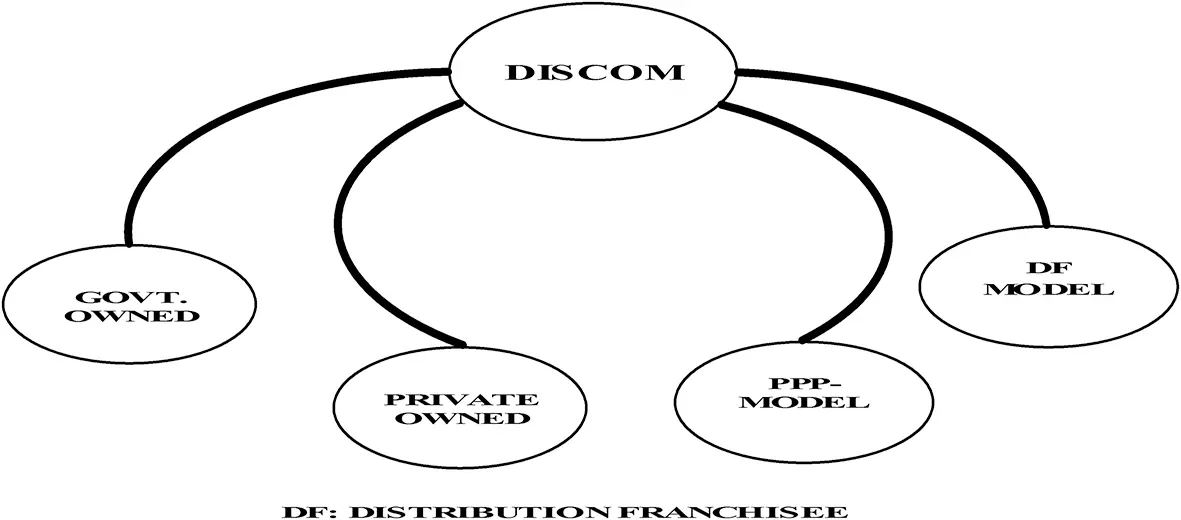
Figure 1.1 Different distribution models evolved.
1.3.1 Government-Owned DISCOM
In this case, ownership of the distribution company (DISCOM) lies with the government. Government-owned DISCOM can again be categorized into two categories, a single vertical structure and an unbundled (corporatized) structure. In the case of a single vertical structure, a single entity that is government owned performs all the tasks of power generation, transmission, and distribution. However, following the trends of reform, unbundling this single vertical structure led to segregation of generation, transmission, and distribution as distinct companies. Again this segregation was done either to single generation, single transmission, and single distribution companies or to multiple generation, multiple transmission, and multiple distribution companies. Some utilities unbundled their single vertical structure into two entities – one dedicated to transmission and another dedicated to both generation and distribution. Similarly, some utilities unbundled their single vertical structure into two entities – one dedicated to generation and another dedicated to both transmission and distribution. Figures 1.2 and 1.3 show various forms of government owned distribution companies.

Figure 1.2 Single vertical structure.
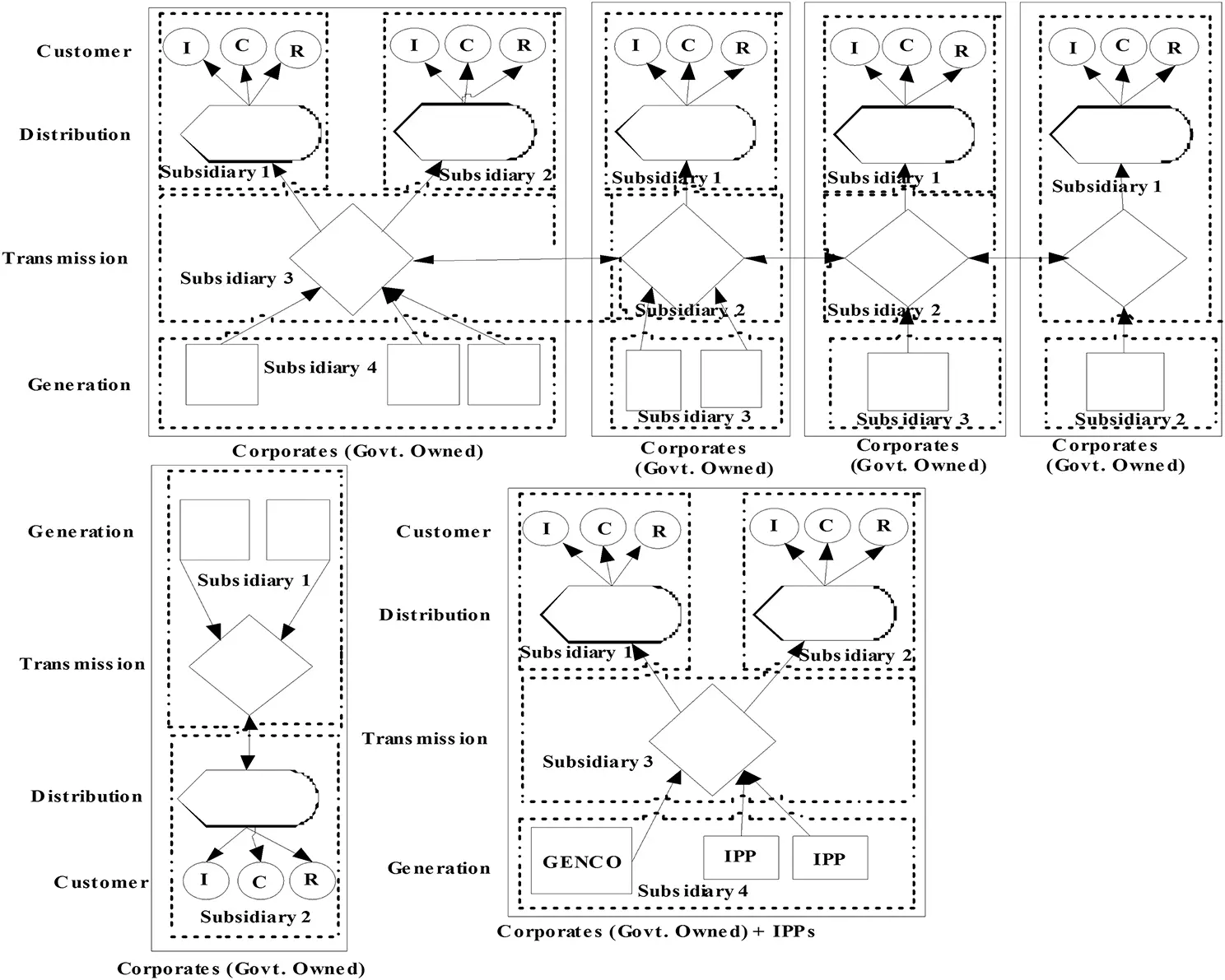
Figure 1.3 Unbundled structure.
From Figure 1.2, it is clear that the task of generation, transmission, and distribution is under the purview of a single entity, irrespective of whether there are single or multiple subsidiaries in generation or transmission or distribution.
Figure 1.3 consists of six different blocks where all the six blocks represent a distinct pattern of unbundled power distribution structure. In the first block, more than one subsidiary are being shown for both the generation and distribution segments whereas transmission has been shown as a single subsidiary because most of the countries kept a single transmission utility while undergoing unbundling. Although a vertical integrated structure and unbundled (corporatized) structures are different in structures no significant differences are found in their operations and functions. The relative concerns relating to this model are:
Читать дальшеИнтервал:
Закладка:
Похожие книги на «Active Electrical Distribution Network»
Представляем Вашему вниманию похожие книги на «Active Electrical Distribution Network» списком для выбора. Мы отобрали схожую по названию и смыслу литературу в надежде предоставить читателям больше вариантов отыскать новые, интересные, ещё непрочитанные произведения.
Обсуждение, отзывы о книге «Active Electrical Distribution Network» и просто собственные мнения читателей. Оставьте ваши комментарии, напишите, что Вы думаете о произведении, его смысле или главных героях. Укажите что конкретно понравилось, а что нет, и почему Вы так считаете.
